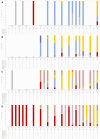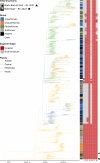Avian influenza viruses in wild birds in Canada following incursions of highly pathogenic H5N1 virus from Eurasia in 2021-2022
- PMID: 39012149
- PMCID: PMC11323545
- DOI: 10.1128/mbio.03203-23
Avian influenza viruses in wild birds in Canada following incursions of highly pathogenic H5N1 virus from Eurasia in 2021-2022
Abstract
Following the detection of novel highly pathogenic avian influenza virus (HPAIV) H5N1 clade 2.3.4.4b in Newfoundland, Canada, in late 2021, avian influenza virus (AIV) surveillance in wild birds was scaled up across Canada. Herein, we present the results of Canada's Interagency Surveillance Program for Avian Influenza in Wild Birds during the first year (November 2021-November 2022) following the incursions of HPAIV from Eurasia. The key objectives of the surveillance program were to (i) identify the presence, distribution, and spread of HPAIV and other AIVs; (ii) identify wild bird morbidity and mortality associated with HPAIV; (iii) identify the range of wild bird species infected by HPAIV; and (iv) genetically characterize detected AIV. A total of 6,246 sick and dead wild birds were tested, of which 27.4% were HPAIV positive across 12 taxonomic orders and 80 species. Geographically, HPAIV detections occurred in all Canadian provinces and territories, with the highest numbers in the Atlantic and Central Flyways. Temporally, peak detections differed across flyways, though the national peak occurred in April 2022. In an additional 11,295 asymptomatic harvested or live-captured wild birds, 5.2% were HPAIV positive across 3 taxonomic orders and 19 species. Whole-genome sequencing identified HPAIV of Eurasian origin as most prevalent in the Atlantic Flyway, along with multiple reassortants of mixed Eurasian and North American origins distributed across Canada, with moderate structuring at the flyway scale. Wild birds were victims and reservoirs of HPAIV H5N1 2.3.4.4b, underscoring the importance of surveillance encompassing samples from sick and dead, as well as live and harvested birds, to provide insights into the dynamics and potential impacts of the HPAIV H5N1 outbreak. This dramatic shift in the presence and distribution of HPAIV in wild birds in Canada highlights a need for sustained investment in wild bird surveillance and collaboration across interagency partners.
Importance: We present the results of Canada's Interagency Surveillance Program for Avian Influenza in Wild Birds in the year following the first detection of highly pathogenic avian influenza virus (HPAIV) H5N1 on the continent. The surveillance program tested over 17,000 wild birds, both sick and apparently healthy, which revealed spatiotemporal and taxonomic patterns in HPAIV prevalence and mortality across Canada. The significant shift in the presence and distribution of HPAIV in Canada's wild birds underscores the need for sustained investment in wild bird surveillance and collaboration across One Health partners.
Keywords: H5N1; avian influenza; highly pathogenic avian influenza virus; low pathogenicity avian influenza virus; reservoir; surveillance; wild birds.
Conflict of interest statement
The authors declare no conflict of interest.
Figures









Comment in
-
Broadening the aims of avian influenza surveillance according to the One Health approach.mBio. 2024 Oct 16;15(10):e0211124. doi: 10.1128/mbio.02111-24. Epub 2024 Sep 18. mBio. 2024. PMID: 39291995 Free PMC article.
References
-
- Caliendo V, Lewis NS, Pohlmann A, Baillie SR, Banyard AC, Beer M, Brown IH, Fouchier RAM, Hansen RDE, Lameris TK, Lang AS, Laurendeau S, Lung O, Robertson G, van der Jeugd H, Alkie TN, Thorup K, van Toor ML, Waldenström J, Yason C, Kuiken T, Berhane Y. 2022. Transatlantic spread of highly pathogenic avian influenza H5N1 by wild birds from Europe to North America in 2021. Sci Rep 12:11729. doi:10.1038/s41598-022-13447-z - DOI - PMC - PubMed
-
- Alkie TN, Lopes S, Hisanaga T, Xu W, Suderman M, Koziuk J, Fisher M, Redford T, Lung O, Joseph T, Himsworth CG, Brown IH, Bowes V, Lewis NS, Berhane Y. 2022. A threat from both sides: multiple introductions of genetically distinct H5 HPAI viruses into Canada via both East Asia-Australasia/Pacific and Atlantic flyways. Virus Evol 8:veac077. doi:10.1093/ve/veac077 - DOI - PMC - PubMed
-
- Alkie TN, Byrne AMP, Jones MEB, Mollett BC, Bourque L, Lung O, James J, Yason C, Banyard AC, Sullivan D, Signore AV, Lang AS, Baker M, Dawe B, Brown IH, Berhane Y. 2023. Recurring trans-atlantic incursion of clade 2.3.4.4b H5N1 viruses by long distance migratory birds from northern Europe to Canada in 2022/2023. Viruses 15:1836. doi:10.3390/v15091836 - DOI - PMC - PubMed
MeSH terms
LinkOut - more resources
Full Text Sources
Medical
Miscellaneous
